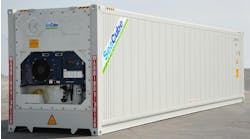Smart trailer lighting systems maximize fleet uptime, minimize maintenance costs, CSA exposure
FOR OEMs, fleet managers and owner-operators of Class 7 or 8 trucks, keeping all the various lights on a trailer functioning properly can eliminate a considerable amount of trouble. This includes avoiding CSA (Compliance, Safety, Accountability program) fines or citations for severity points, but also eliminating a glaring reason for law enforcement to pull the vehicle over.
In fact, more than 25% of all CSA violations in the heavy-duty trucking industry are related to lighting outages from inoperable lamps or defective/broken lights. As such, it represents one of the largest annual expense items, when CSA fines, maintenance, downtime and repair are factored together.
Given that lighting-related CSA violations are so common, the industry is responding with new “smart” systems that provide continuous, real-time monitoring of all lights on the trailer to identify outages or electrical shorts.
For notifications and alerts, today’s solutions go far beyond the flashing indicator lights of the past. In more advanced systems, real-time status of every light on the trailer can be transmitted via on-board telematics or wirelessly through Bluetooth, where it can be accessed through a user-friendly smartphone app.
Armed with this level of information, owner-operators as well as fleet and maintenance managers are able to maximize safety and increase uptime, while minimizing CSA exposure.
Lighting systems get smarter
Every trailer requires fully functioning lamps at all times on the road. This includes those for stop, left and right turn signal, tail, license, clearance, side marker, and identification. However, problems arise due to lamps burning out, corrosion in the wiring or plugs, electrical shorts or issues related to shock, vibration or physical damage.
Fortunately, lighting issues are typically resolved quite easily with spare fuses, replacement lights/bulbs and the right tools. The difficulty, therefore, is simply knowing a problem exists so it can be addressed immediately.
Although pre- and post-trip inspections (if conducted diligently) may expose a problem with one or more of the lights, outages that occur while on the road may not be known about until much later. As already suggested, this could draw the attention of law enforcement and even raise the possibility of additional CSA citations.
“Lights that are out are an easy target for a state trooper,” said Kevin Cornelius, business development manager of power delivery at Grote Industries, a global manufacturer of lighting and safety equipment for trucking fleets. “When a truck is pulled over, it can trigger the officer to investigate everything else like the driver logs, brake wear or tire tread.”
Although there are lighting monitoring products available, until recently there have been a few drawbacks, said Cornelius. One system utilizes only a flashing light to indicate an outage. Another uses an indicator light on the outside of the truck, but can also be connected to telematics. However, it works only with LEDs and requires extensive trailer alteration for installation.
However, a new approach called the Grote Guardian Smart System can be easily integrated into the trailer’s wiring harness system at the nose box. The system was created in collaboration with one of the largest trailer manufacturers in North America, and is currently being used by more than a dozen fleets across the country.
The fully integrated smart system delivers real-time status of the entire trailer lighting system and works with any type of lamp.
This system’s sensor continuously monitors voltage and current passing through the wire harness. The system is programmed to differentiate notable or sudden changes from those that are gradual and could be caused by lights warming up or ambient temperature conditions.
The system alerts a driver, maintenance or fleet manager using a smartphone app, or it can be connected to the on-board telematics system. All the information on status and any changes are logged in cloud-based storage for data analysis.
According to Cornelius, the same sensors could be used to measure temperature, humidity, pressure, or other factors as part of a bumper-to-bumper solution as the industry moves more toward monitoring additional tractor-trailer functions.
Because of the importance of collecting accurate data, Cornelius adds that the wire harnesses used should be extremely reliable and resistant to corrosion for the smart systems to function optimally.
For this reason, he recommends utilizing wire harnesses that are resistant to moisture, chemical and UV attack, that will stay flexible and not harden or crack. Although this type of wire harness is available from Grote, Cornelius notes that the Grote Guardian Smart System works with wire harnesses and lamps from other manufacturers as well.
Next-generation smart systems
One aspect of the next-generation system from Grote that is of particular interest to trailer OEMs and fleet managers is a “geo-fence” feature that will automatically upload trailer lighting and electrical system information and send alerts for priority attention, as needed.
Geo-fencing allows a virtual geographic boundary to be drawn around a specific location, such as a facility or repair depot. When the geo-fence is crossed and there is a lamp or light outage, it can be programmed to automatically trigger a warning via e-mail or text message to appropriate personnel.
“Once the tractor-trailer crosses the established geo-fence, the maintenance manager will immediately be notified,” said Cornelius. “This approach could even allow for automatic electronic ordering of replacement lamps, if desired.”
Although some companies charge a monthly subscription fee for this type of service, Cornelius said Grote has no current plans to charge for the geo-fencing feature.
“The ability to proactively identify and resolve any lighting, electrical, or other tractor-trailer issues will only grow as this kind of real-time monitoring system becomes more sophisticated,” said Cornelius. “In the trucking industry, access to this type of information is going to reduce CSA violations and ensure safer, simpler operation.”
For more information, contact Grote at 2600 Lanier Drive, Madison IN 47250; phone: 800-628-0809; e-mail [email protected]; or access www.grote.com/guardian.
Del Williams is a technical writer based in Torrance CA.



